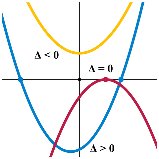|
|
|
|
|
|
|||||||||
|
|
|||||||||||||
UNIT 4 : POLYNOMIAL
AND RATIONAL FUNCTIONS
LESSON 1:
POLYNOMIAL FUNCTIONS INTRODUCTION

Example 1:
f(x) = x3 4x2 + x + 6 is a cubic polynomial function because the largest exponent of the variable is 3. Make a table of values or use
a graphing calculator to draw its graph [see below].
 Note: The
function has 3 zeros (x intercepts), x = -1, 2, 3 and two
Note: The
function has 3 zeros (x intercepts), x = -1, 2, 3 and two
turning points A and B. Turning point A is a local maximum point as
the function changes from increasing to decreasing at A. Turning point B
is a local minimum point as the function changes from decreasing to increasing
at B. The function has a local maximum value of y = 6.1 at point A and a
local minimum value of y = -0.9 at point B.

Example 2:
Use your graphing calculator to graph and study the cubic functions below.
a) f(x) = x3 x2 + 5x 3 b) f(x) = (x 3)3 + 1


c) f(x) = x3 + 3x2 + 3x + 2

Note: From
the examples above we can make the following observations.
- A cubic function can have 1, 2 or 3 zeros (x-intercepts)
- It can have 0 or 2 turning points.
- The coefficient of x3 is called the leading coefficient (k). In (a) the leading coefficient is negative(k = -1) and the function rises to the left and falls to the right.
- The leading coefficient(k) determines the end behaviours. If k > 0, the function falls to the left and rises to the right (ex. 1, 2 b,c)
If k < 0, the function rises to the left and falls to the right (ex. 2a). This characteristic is true for all polynomial functions of odd degree (1, 3, 5, ).
Example 3:
Use your graphing calculator to graph and study the quartic functions below.
a) f(x) = x4 + x3 5x2 3x b) y = x4 + x3 2x2 3x


c) y = -0.5x4 x3 + 2x2 5 d) y = x4 + x3 2x2 3x + 3


Note: From
the examples above we can make the following observations.
- A quaric function can have 0,1, 2, 3 or 4 zeros (x-intercepts)
- It can have 1 or 3 turning points.
- The coefficient of x4 is called the leading coefficient (k). In (c) the leading coefficient is negative(k = -0.5) and the function falls to the left and right.
In (a,b,d) the leading coefficient is positive and the function rises to the left and right
- The leading coefficient(k) determines the end behaviours. If k > 0, the function rises to the left and right (ex. 3 a,b,d)
If k < 0, the function falls to the left and right (ex. 3c). This characteristic is true for all polynomial functions of even degree (2, 4, 6, ).
Polynomial Functions in Factored Form f(x) = k(x a)(x b)(x c) . . . etc.
Linear Functions in factored Form: f(x) = k(x a)



Quadratic Functions in factored Form: f(x) = k(x a)(x b)




Cubic Functions in factored Form: f(x) = k(x a)(x b)(x c)


![]()
|
x |
y |
|
-2 |
6 |
|
0 |
-6 |

Quartic Functions in factored Form: f(x) = k(x a)(x b)(x c)(x d)



|
x |
y |
|
-1 |
16 |
|
2 |
16 |






